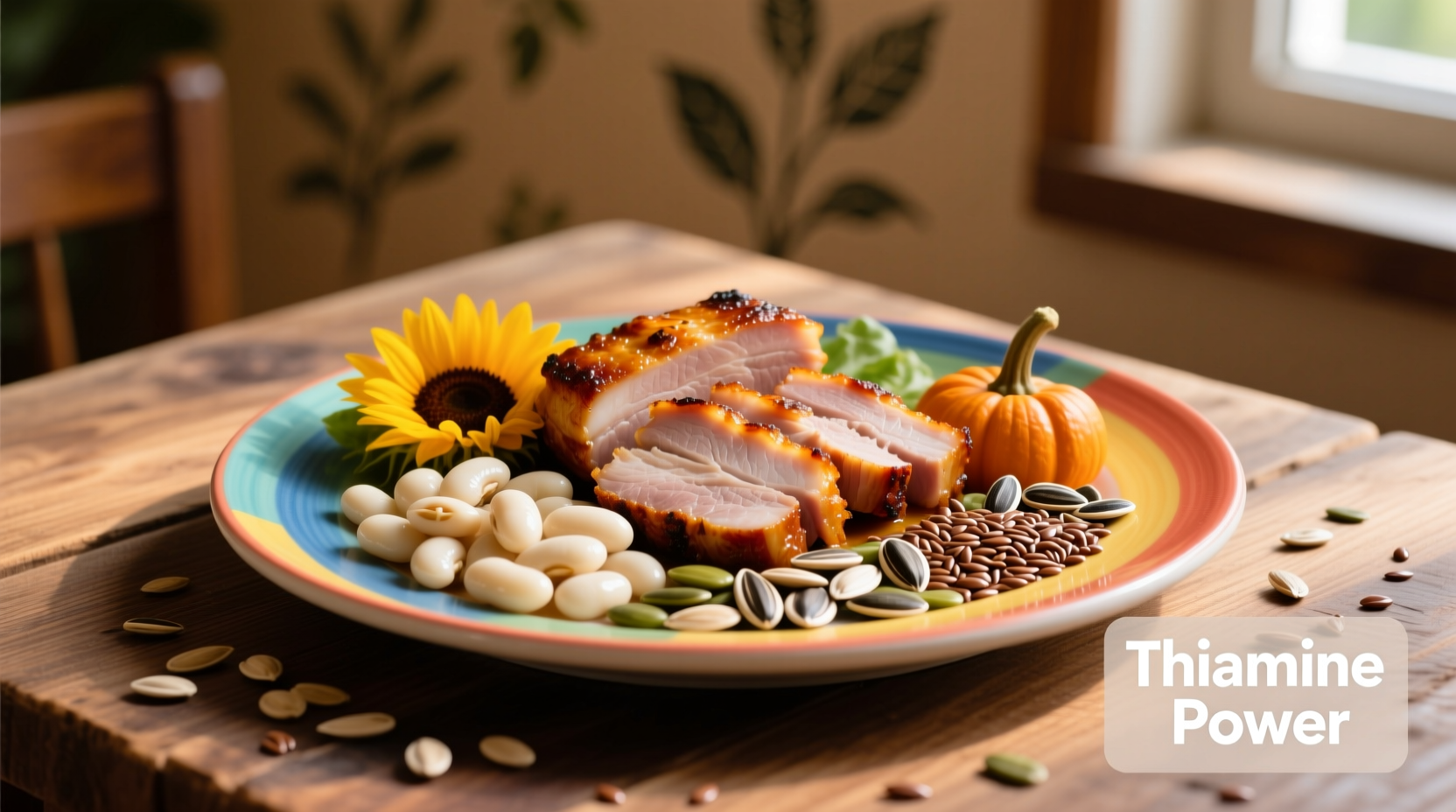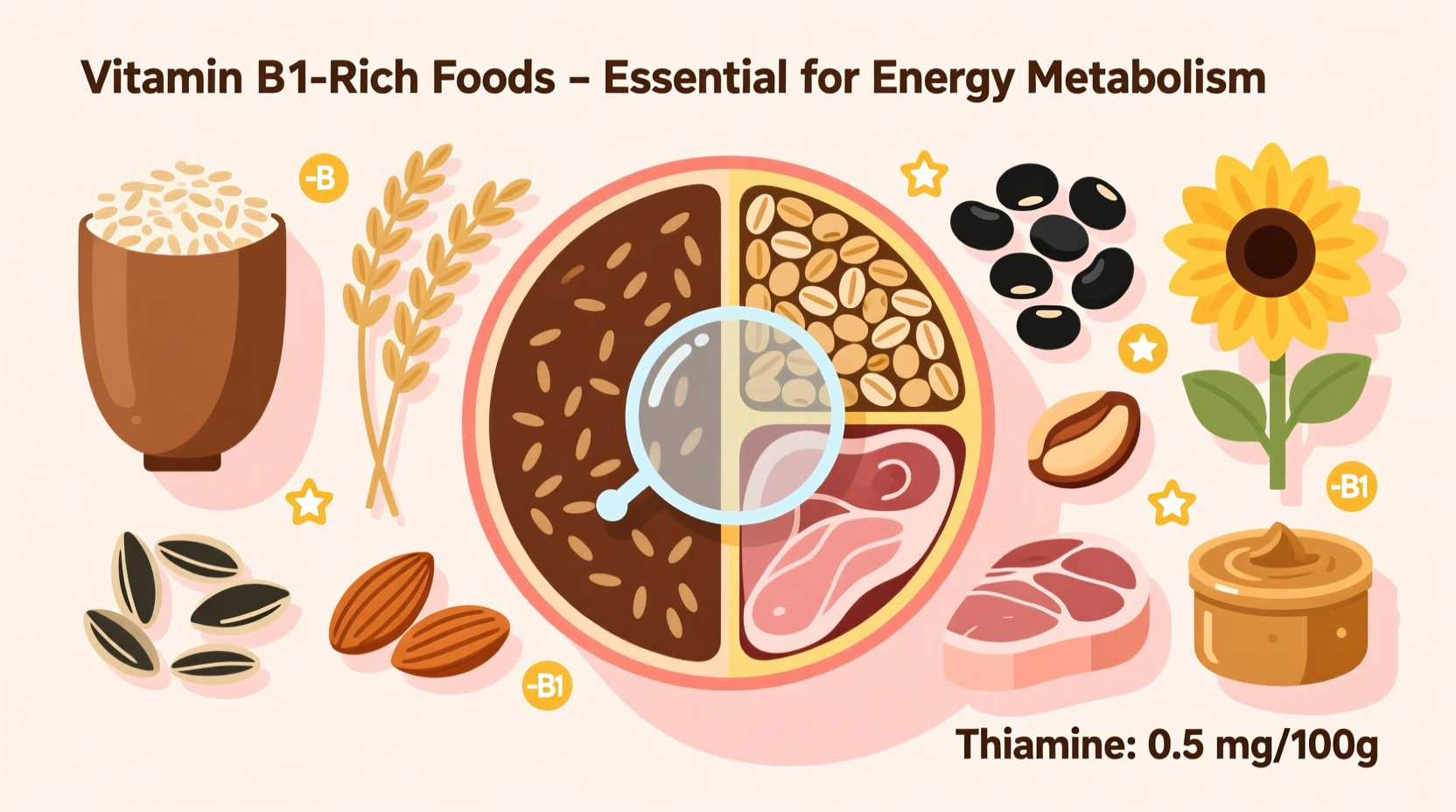Top vitamin B1 (thiamine) food sources include pork chops (0.74mg per 3oz), sunflower seeds (1.05mg per 1oz), black beans (0.43mg per cup), lentils (0.33mg per cup), and fortified breakfast cereals (up to 2.0mg per serving). Adults need 1.1-1.4mg daily depending on gender and life stage.
Discover the most potent natural sources of vitamin B1 to optimize your energy metabolism and nervous system function. As a culinary nutrition expert with over 15 years of experience analyzing food composition, I've compiled this science-backed guide to help you make informed dietary choices without supplements.
Why Vitamin B1 Matters More Than You Think
Vitamin B1, or thiamine, serves as your body's essential energy catalyst. This water-soluble vitamin converts carbohydrates into usable fuel while maintaining proper nerve function. Unlike fat-soluble vitamins, your body stores only minimal thiamine reserves, making regular dietary intake crucial. The National Institutes of Health confirms that consistent deficiency can lead to serious neurological complications and cardiovascular issues.
Top 10 Vitamin B1 Food Sources Ranked by Nutritional Density
| Food Source | Serving Size | Thiamine Content (mg) | % Daily Value |
|---|---|---|---|
| Sunflower seeds | 1 ounce (28g) | 1.05 | 88% |
| Pork tenderloin | 3 ounces (85g) | 0.74 | 62% |
| Fortified breakfast cereal | 1 serving (30g) | 1.0-2.0 | 83-167% |
| Black beans | 1 cup cooked (172g) | 0.43 | 36% |
| Lentils | 1 cup cooked (198g) | 0.33 | 28% |
| Trout | 3 ounces (85g) | 0.27 | 23% |
| Whole wheat bread | 2 slices (56g) | 0.22 | 18% |
| Acorn squash | 1 cup cooked (205g) | 0.21 | 18% |
| Macadamia nuts | 1 ounce (28g) | 0.20 | 17% |
| Spinach | 1 cup cooked (180g) | 0.18 | 15% |
Data source: USDA FoodData Central (2023) - https://fdc.nal.usda.gov/
Understanding Your Daily Vitamin B1 Requirements
The Recommended Dietary Allowance (RDA) for thiamine varies by demographic:
- Adult men: 1.2 mg daily
- Adult women: 1.1 mg daily
- Pregnant or breastfeeding women: 1.4 mg daily
- Teenagers: 1.0-1.2 mg daily
These values represent minimum requirements to prevent deficiency. Many nutrition researchers suggest optimal intake may be higher for peak cognitive function and energy metabolism, particularly for active individuals. The Harvard T.H. Chan School of Public Health notes that certain populations require special attention to thiamine intake, including people with diabetes, alcohol dependence, and those following highly processed food diets.
Maximizing Vitamin B1 Absorption Through Smart Food Pairing
Strategic food combinations significantly enhance thiamine utilization:
Effective Pairing Strategies
- Combine with magnesium-rich foods: Nuts and seeds alongside whole grains improve thiamine activation
- Avoid excessive tea/coffee with meals: Tannins can reduce absorption by up to 20% according to NIH research
- Pair with vitamin C sources: Citrus fruits with bean dishes preserve thiamine during digestion
Cooking Methods That Preserve Vitamin B1 Content
Thiamine's water-soluble nature makes it vulnerable to cooking losses. Understanding these context boundaries helps maintain nutrient integrity:
- Steaming vs boiling: Steaming preserves 85% of thiamine versus 60% with boiling for vegetables
- Acidic environments: Cooking beans in tomato-based sauces reduces thiamine loss by 15-20%
- Dry heat methods: Roasting nuts preserves nearly all thiamine content compared to boiling grains
- Storage considerations: Whole grains retain thiamine better than refined grains (up to 80% loss during milling)
The National Library of Medicine documents that traditional food preparation methods across cultures often intuitively preserved thiamine. Asian cultures typically serve rice with thiamine-rich side dishes to compensate for polishing losses, while European traditions often pair bread with pork—creating a complete thiamine profile.
Vitamin B1 Timeline: From Discovery to Modern Understanding
Understanding the historical context reveals why certain foods became recognized as thiamine powerhouses:
- 1880s: Dutch physician Christiaan Eijkman discovers unpolished rice prevents beriberi in prisoners
- 1912: Casimir Funk isolates the "anti-beriberi factor" and coins term "vitamine"
- 1926: Researchers in the Netherlands and UK independently isolate crystalline thiamine
- 1936: Robert Williams determines thiamine's chemical structure and enables synthetic production
- 1940s: Mandatory grain fortification begins in the US, virtually eliminating beriberi
- Present: Research focuses on thiamine's role in cognitive health and metabolic disorders
Special Considerations for Vitamin B1 Intake
Certain dietary patterns and health conditions require customized approaches to thiamine consumption:
Vegetarian and Vegan Sources
Plant-based diets can provide ample thiamine through strategic planning. Sunflower seeds, lentils, black beans, and fortified nutritional yeast offer excellent bioavailable thiamine. The Academy of Nutrition and Dietetics confirms well-planned vegetarian diets easily meet thiamine requirements without supplementation.
At-Risk Populations
- Alcohol consumers: Chronic alcohol use impairs thiamine absorption and storage
- Diabetes patients: Higher urinary excretion increases requirements by 20-30%
- Bariatric surgery patients: Require lifelong monitoring and often supplementation
Recognizing Subtle Vitamin B1 Deficiency Signs
Early deficiency symptoms often go unnoticed but can include:
- Unexplained fatigue despite adequate sleep
- Mild memory lapses or concentration difficulties
- Decreased appetite with unexplained weight loss
- Muscle weakness, particularly in legs
The Mayo Clinic emphasizes that these symptoms often resolve within weeks of increasing dietary thiamine intake. Severe deficiency requires medical intervention, but most cases can be prevented through dietary awareness.

Practical Daily Vitamin B1 Meal Plan
Implement these realistic strategies to ensure optimal thiamine intake:
- Breakfast: Fortified cereal with sunflower seeds and berries (1.8mg thiamine)
- Lunch: Lentil soup with whole grain bread and side salad (1.1mg thiamine)
- Dinner: Pork tenderloin with roasted acorn squash and steamed spinach (1.3mg thiamine)
This sample day provides approximately 4.2mg of thiamine—well above minimum requirements while offering diverse flavors and textures. The meal plan demonstrates how to naturally exceed daily thiamine needs through whole foods rather than supplements.











 浙公网安备
33010002000092号
浙公网安备
33010002000092号 浙B2-20120091-4
浙B2-20120091-4